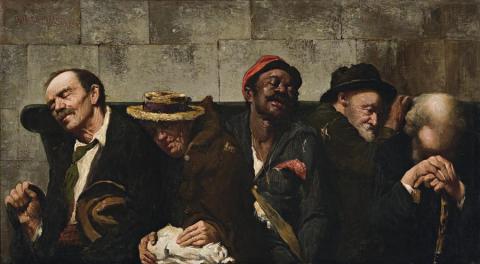POVERTY MAKES STRANGE BEDFELLOWS, 1905
A. Dattilo-Rubbo
oil on canvas on board
76.0 x 137.0 cm
signed, inscribed and dated upper left: A. Dattilo Rubbo, Sydney, 1905
Mr McLeod of the Bulletin, 1906
The Holmes à Court Collection, Perth
Deutscher Fine Art, Melbourne
The Hicks Family Collection, Melbourne
‘Cigarette', 'Australian Painters: IV, Datillo-Rubbo', The Red Funnel, Sydney, 1 October 1906, pp. 245, (illus.), 246
The Lone Hand, 1 March 1909, (illus.) facing page 483
When Antonio Dattilo-Rubbo stood on the docks of his native Naples as a young art student he saw 'a most beautiful girl come ashore from an Australian boat; so I say 'Some day I go to Australia!''1 That he did in 1897 - and married an Australian girl. Antonio Salvatore Dattilo, better known as Dattilo-Rubbo because of his adoption of his mother's name, studied at the School of Drawing of the Rome Technical School, taking out a prize when only fourteen years old. The Royal Academy of Fine Arts in Naples followed where his teacher Domenico Morelli encouraged students to sketch the city's rich street life. This interest continued in Dattilo-Rubbo's later art, as seen in Poverty Makes Strange Bedfellows and other works of a strong social realist nature such as the autobiographically inclined The Breadwinner, Old Age Pensioners in the collection of the Art Gallery of South Australia, and A Veteran c.1899 in the Art Gallery of New South Wales. In Sydney, Dattilo- Rubbo became one of the city's leading teachers, his school being a rival to Julian Ashton's Sydney Art School. Although academically trained and traditional in style, Dattilo-Rubbo encouraged originality and innovation among his students, who included the pioneer Sydney Post-Impressionists Grace Cossington Smith, Roland Wakelin and Roy de Maistre.
Rich in figurative interest, Poverty Makes Strange Bedfellows was one of Dattilo-Rubbo's most popular paintings, being featured in such contemporary publications as The Red Funnel and The Lone Hand.2 The Lone Hand, which was published in Sydney from 1907, supported local artists and writers in its encouragement of an independent Australian culture. Artist-contributors included Norman Lindsay, who played an influential role in its establishment, Hans Heysen, and B. E. Minns, with articles written by Billy Hughes, Nellie Melba, and William Moore. In Poverty Makes Strange Bedfellows a mixed group of people sits on a bench set against a grey, textured stonewall, cold and unrelenting. Eyes are closed, expressions ranging from pain through exhaustion to resignation. Faces, in profile and full, reveal their ages - the younger, mature man a red-capped Negro with a cross on a chain, the anonymous white haired man bent over his walking stick, the older woman, a man rejected by employment. Such empathy with the aged is combined with sympathy for the downtrodden as in The Strike's Aftermath, 1913, in the Art Gallery of New South Wales.
1. 'Cigarette', op. cit., p. 246
2. ibid
DAVID THOMAS
